Unveiling The Darkness: The 1981 Massacre In Post-Revolutionary Iran
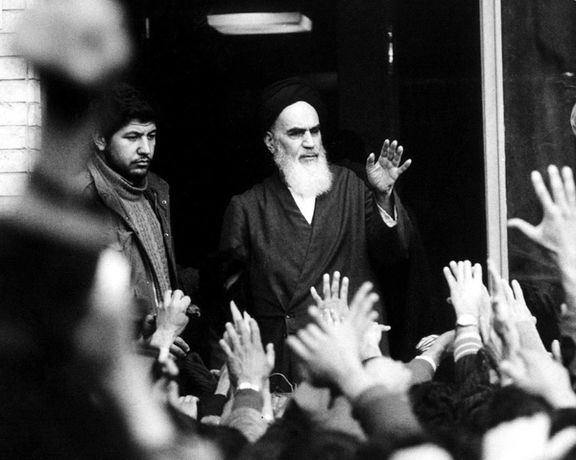
As the Islamic Regime of Iran celebrates its 45th anniversary, it's crucial to reflect on the profound significance of human rights, accountability, and justice.

As the Islamic Regime of Iran celebrates its 45th anniversary, it's crucial to reflect on the profound significance of human rights, accountability, and justice.
Delving into the dark chapter of Iran's history, we confront the grim realities of the 1981 massacre, witnessing the extent of the atrocities and their enduring impact on the nation's legal foundations. This sad reflection serves as a stark reminder of the imperative to uphold human rights and ensure accountability in the wake of mass atrocities.
In the wake of the 1979 revolution that toppled the Shah of Iran and established the Islamic Republic, the world watched with anticipation as the country embarked on a new path. Iran was at a crossroads, transitioning from a monarchy to an Islamic republic led by Shia clerics. However, what followed was a period marked by political turmoil, violent oppression, and a ruthless crackdown on dissent that remains one of the darkest chapters in Iran's history. The executions of the former regime’s government officials and army leaders right after the revolution, followed by the 1981 massacre in Iran initiated by a Fatwa from Ayatollah Khomeini, the Supreme Leader at the time, stand as a haunting reminder of the brutality that can accompany political transitions.
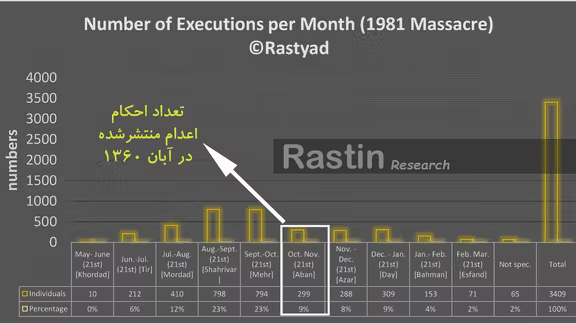
The 1981 Massacre: A Forgotten Tragedy
Shortly after the 1979 revolution, Shia clerics seized control of most political institutions in Iran, rapidly consolidating their power. This newfound regime embarked on a mission to establish a religious dictatorship in the Middle East's second-largest country. Their approach was characterized by totalitarian tendencies and an iron grip on the nation's political landscape.
One of the most horrifying aspects of this regime's consolidation of power was the 1981 massacre, a mass atrocity that received insufficient attention in the years that followed. This massacre, which occurred between June 1981 and March 1982, targeted a wide range of political opponents, including communists, socialists, social democrats, moderate Islamists, liberals, monarchists, and followers of the Bahá'í Faith. It stands as one of the most extensive atrocities committed by the Islamic Republic of Iran after the 1979 revolution.
The mass killings of political prisoners in Iran in 1981 were not spontaneous acts of violence. They were deliberate, organized, and well-planned crimes against humanity. These atrocities involved various factors, including personal identity issues and conflicts between different religious, political, and social groups. The Islamic Government of Iran did not hide this massacre; they proudly announced the names of the executed in newspapers, publicly boasted about it, and defended themselves vehemently when faced with international condemnation.
To gain a comprehensive understanding of the 1981 massacre, it is essential to delve into the research conducted by the Rastyad Collective and the revelations it has brought forth. Their site documents over 3500 executions across 85 cities, shedding light on the tragic fate of many. Their meticulous examination of the events surrounding the massacre affirms the widely held belief that it transpired within a legal vacuum, with the state resorting to extra-legal means of violence to assert control. Furthermore, their findings shed light on the significant impact of this massacre in shaping the legal framework of Iran's theocratic regime. By perpetrating such egregious acts, the regime instilled fear and apathy among the populace, solidifying its grip on power and stifling dissent.
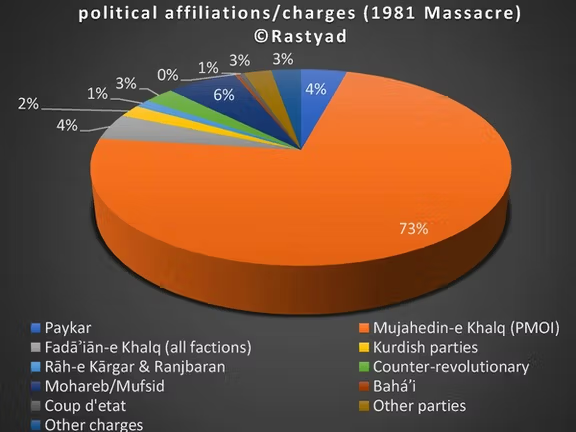
On a political level, the massacre unfolded within a crisis triggered by post-revolutionary circumstances. The clerical rule seized power by suspending the pre-revolutionary legal order, allowing them to monopolize political power. On a legal level, the execution of political dissidents occurred within this legal vacuum. Establishing Islamic Revolutionary Courts and ratifying the first Islamic Penal Code in 1982 were crucial steps that solidified the regime's legal foundations.
The Rastyad Collective's research firmly establishes that the 1981 massacre was carried out in a legal vacuum. The extra-legal use of state violence was employed to eliminate political dissidents and critics. This practice involved ill-grounded and ruthless legal proceedings and trials, leading to the sentencing of thousands to death. These actions epitomized a political system willing to resort to brutality to silence opposition and maintain power. The Rastyad Collective's research underscores the role of the 1981 massacre in the development and ratification of Iran's legal framework and the consolidation of a totalitarian theocratic system. It provides a harrowing account of state violence and its enduring impact on the nation's political and legal landscape.
What distinguished the 1981 massacre from other atrocities of the Islamic Regime of Iran is its unique legal status. The trials of the accused lacked the standards of a fair trial, and the judicial authority responsible for issuing death sentences, as well as the crimes based on which these sentences were issued, did not exist in Iran's judicial laws at the time. Revolutionary courts sentenced thousands of people to death without a defined status or jurisdiction in Iran's judicial system. These courts operated illegally for nearly two decades until they were incorporated into the official judicial system in 1994.
Many individuals executed in 1981 were accused of "Moharebeh" (waging war against God) or "Mofsed-e-filarz" (corruption on earth). However, these crimes were not defined in Iran's judicial laws until later, and their inclusion was gradually added to the Islamic Penal Code in 1982. Due to the lack of legal basis for the charges and the absence of fair trial procedures, the executions carried out in 1981 are considered illegal and examples of "state murder."
Another particularly distressing aspect of the 1981 massacre was the execution of children under the age of 18. This occurred despite international commitments not to execute children under the age of 18, which were still valid from the previous regime. In documenting the tragic loss of innocent lives, particularly children, during a dark period in Iran's history, Rastyad reports that only in Behesht-e-Zahra cemetery plot 41, 104 graves belong to underage children.
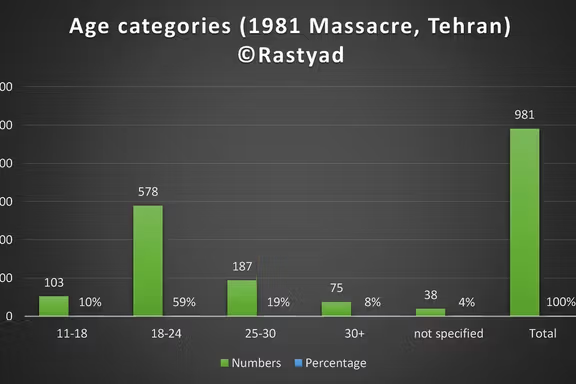
Last year, Javid Rahman, the UN Special Rapporteur on Iran, spoke at an event organized by the University of Amsterdam and the Netherlands Institute for War, Holocaust, and Genocide Studies. He emphasized the pivotal role of research on the 1981 Massacre in unraveling the complex web of connections between the past atrocities of the Islamic Regime of Iran and present-day human rights abuses. The findings offer invaluable insights into the mechanisms of state-sponsored violence and the enduring trauma inflicted upon countless individuals and families.
Furthermore, Rahman explored the far-reaching implications of the 1981 massacre on Iran's legal and judicial systems. He underscored how the establishment of revolutionary courts and the normalization of child executions represented grave violations of international human rights law, perpetuating a culture of impunity and injustice.
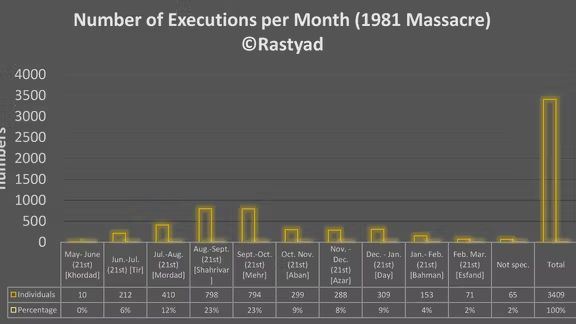
The legacy of the 1981 massacre continues to haunt Iran, with ongoing human rights abuses perpetrated by the Islamic Regime. The regime's current practices, including arbitrary arrests, enforced disappearances, and extrajudicial killings, reflect a pattern of impunity and disregard for basic human rights. Despite international condemnation, perpetrators of these atrocities continue to operate with impunity, further underscoring the urgent need for accountability and justice.
In conclusion, the legacy of the 1981 massacre continues to haunt Iran, with ongoing human rights abuses perpetrated by the Islamic Regime. The regime's current practices, including arbitrary arrests, enforced disappearances, and extrajudicial killings, reflect a pattern of impunity and disregard for basic human rights. Despite international condemnation, perpetrators of these atrocities continue to operate with impunity, further underscoring the urgent need for accountability and justice. Building upon this, the international community must heed the lessons of history and confront the legacy of the 1981 massacre with courage and determination. World leaders must prioritize human rights and justice in their dealings with Iran, ensuring that the victims of past atrocities are not forgotten and that future generations are spared from similar suffering. By amplifying the voices of the victims and advocating for accountability, we can pave the way for a brighter, more equitable future for Iran and its people.